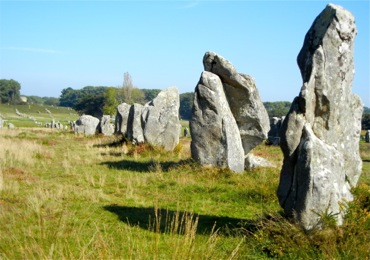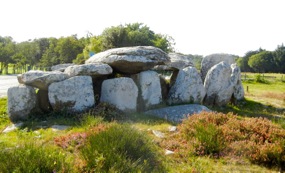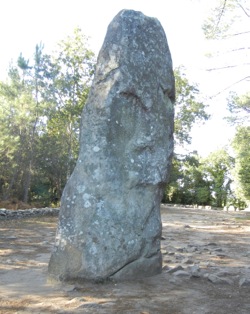 |
Carnac, Brittany, France | |
| These fascinating megalithic monuments provide insights and raise questions about our Neolithic ancestors. | ||
|
|
||
|
|
|
Carnac is a small Breton village near the Golfe du Morbihan, just a short distance from the lovely Quiberon Peninsula. Carnac may be small, but its history is long. About 3000 megalithic monuments, dating from the fifth to the third mlllenium BC, are arranged in various formations around Carnac. Called menhirs, which means long stone in Breton, these alignments are truly impressive. Although there are 3000 stones remaining today, experts believe there were twice that many in prehistory. Over the centuries they were put to different uses. As our guide on a visit to the Kermario Alignments said, "Every house in Carnac has a menhir." There are three main megalithic sites in Carnac, as well as other smaller sites, all easily accessible. The Ménec Alignments are just across from the Visitors' Center, right along the road. Consisting of 1050 stones spreading over 950 meters. Just down the road are the Kermario Alignments, the most visited site and the one with the largest megaliths. There is also a dolmen, or chamber, at one end. Farther on, Kerlescan consists of 13 rows of menhirs, some very well preserved. All of the major sites are visible from the road. Smaller sites include the Géant du Manio, a six-meter high megalith set off the road and down a wooded path. Although when I first visited Carnac in 1981 you could simply wander among the stones, erosion and other damage has led to programs to protect the stones and the vegetation surrounding them. Major sites are visited with a guide (information at the Visitors' Center) who ensures that visitors don't harm the ecosystem. In season tours are available in French, English, German, and other languages. So what were these stones for? They are organized in rows, with the largest stones in the west and the smallest stones always in the east. Some speculate that they might be religious sites, and one end appears to have been enclosed. Up until the 1950s people thought the stones were Celtic or Druid, but research at that time showed they were much older. The Celts probably "repurposed" the stones for their own purposes. Although the stones are ancient, Brittany was inhabited long before they were erected. The Prehistoric Museum in Carnac shows the history of Brittany from Paleolithic times (450,000 BC) through the MIddle Ages. A visit to the museum can help put the stones in perspective. If you are interested in Neolithic sites in Brittany, consider going to the Cairn of Barnenez, in the Finistère region. This passage tomb is considered the largest mausoleum in Europe and was built between 4500 and 3900 BCE. If you want to relax after pondering prehistory, head to Carnac-Plage or go to the nearby (30 minute drive) Quiberon Peninsula for beautiful beaches, cliffs, and walking trails. You can also head northwest a half hour to the medieval town of Vannes, at the head of the Golfe du Morbihan.
|
|
Above, Dolmen at the Kermario Alignments, Carnac, France. |


